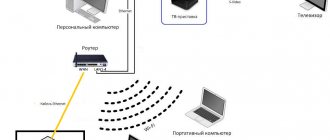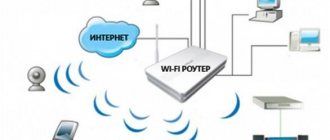Connection technologies
The user himself decides which home Internet is suitable for his situation. There are several connection types:
- mobile internet: G line;
- GPRS;
- LTE;
- xDSL;
- WiFi;
To connect your home Internet, you need to decide on the required characteristics, and then connect the one that best suits the user’s goals and objectives.
ADSL, fiber optic
For online work with a large volume of traffic, xDSL type networks (ADSL, VDSL, etc.) are suitable. The ADSL digital line is connected via the telephone network at speeds of up to 60 Mbit/s. But to install it you need:
- landline phone;
- splitter;
- modem.
Fiber optics is a modern technology that allows you to increase the speed and quality of the connection. It does not rot and is not exposed to rain, snow and sunlight. If the user has the opportunity to connect to a ready-made fiber optic system using cheap passive splitters, then there is no question about which Internet connection is best for the home. Fiber only!
Wireless network
To transmit the Internet over a wireless network, no cable installation is required. The connection is made using a modem that receives and receives signals using WiFi and WiMax technologies. Mobile operators always offer subscribers: “First choose a tariff, and then connect the Internet for home use or for work.” There are several types of connections:
- 2G (connection speed up to 64 kBit/sec);
- 3G (up to 3.6 Mbit/s);
- 4G (up to 100Mbit/s, in some cases up to 1Gbit/s).
Satellite Communications, Dial-Up and Docsis
Satellite Internet connection is an evolutionary way of accessing the World Wide Web. There are two types of connection organization:
- asymmetric (data reception is carried out via satellite communication, and transmission is carried out via any other);
- symmetrical (information is received and transmitted via satellite).
Nothing transmits a signal better than a satellite, and the advantage of this connection is that if there is no telephone line in the area (including fiber optics), then you will still be able to get the Internet, no matter how remote the house is!
Docsis is data transmission via cable television systems (as long as the speed does not exceed 42 Mbit/s).
Dial-up access is an old way of connecting to the Internet using a modem over a telephone line. When accessing the network, the phone is always busy.
How to check if there is a modem in a laptop
Review and configuration of the D-Link Dir-320 modem
Before you run to the consumer electronics store for a 4G modem, you need to check whether the user’s PC has a built-in router. To activate it, just insert a SIM card into the appropriate slot.
Checking its presence or, conversely, absence is quite simple.
- Go through the path “Explorer” - “Computer”.
- Place the mouse cursor over an empty space and right-click, select “System” from the drop-down list.
- In the left column, go to “Device Manager”.
So, if you were able to find the characteristics of the modem in the window, it means it is there, but if not, then the device is simply not equipped with it.
Which technology option is better to choose for an apartment or a private house?
When choosing which Internet connection is best, you need to decide where exactly it will be installed. Good Internet speed in an apartment allows you to choose from a large number of providers for a long time: which one can offer better conditions and connect the network to the apartment at preferential rates, and an agreement will be concluded.
A country house no longer provides such privileges. If the cottage is located far from populated areas and does not have a dedicated telephone line, then you will have to connect the network using wireless technologies. Satellite Internet for home is the best connection option, but it is also the most expensive, so people usually use mobile technologies to access the network from providers:
- Tele 2;
- Beeline;
- MTS;
- Megaphone;
- Yota, etc.
Tips for choosing a router
A router is a device for wirelessly transmitting the Internet via Wi-Fi. The quality of the signal depends on the correctness of its choice.
When purchasing a router, you should consider the following parameters:
- wireless or wired type (a wireless router only connects to an outlet, there are no connections to a network cable, and for a wired device you need to find a place where you can connect to the Internet and install the router there);
- compatibility with the provider (for example, Yota offers its subscribers certain routers);
- software;
- speed (depends on the cost of the device);
- Wi-Fi coverage (for an ordinary apartment a standard D-link router is suitable);
- design (depending on the location of the device): floor-mounted (installed on 4 legs on any smooth surface);
- wall-mounted (they have holes for self-tapping screws);
- portable (typical for mobile Internet);
Rating of the TOP 7 best options for connecting the Internet to your dacha
| Place | Model | Price |
| #1 | Internet kit for the country house 3G/4G | |
| #2 | Set of equipment “Start” | |
| #3 | Ready-made set “Dacha” ONLINE GELIKON-N5 | |
| #4 | 3G Internet kit for the dacha | |
| #5 | Internet kit for the country house Huawei B593-ANT32 | |
| #6 | 3G/4G LTE Internet signal booster kit for a summer residence with Kroks 27 dBi antenna |
Page navigation:
Reviews of the largest providers (geography, technologies, approximate prices)
The decision about which Internet to choose depends on the location of the subscriber, because for each Russian region, in addition to the mainline providers, there are also local ones. And sometimes you can find better deals on tariffs.
But the coverage area and quality of connection of backbone Internet companies is most often the reason for choosing them. The largest providers in Russia include:
- Rostelecom;
- Megaphone;
- RetnNet;
- TTK;
- VimpelCom;
- Er-telecom;
- MTS, etc.
And which Internet provider is the best, each user decides independently.
Rostelecom
Rostelecom is the largest Internet provider in Russia.
Geography
Rostelecom has the largest coverage area due to more than 500 thousand kilometers of network highways. For example, in 2016, the construction of a fiber optic system was completed in the area between Kamchatka, Sakhalin and Magadan! The complex of networks that the Internet provider is building throughout Russia (including in the Arctic Circle) on the basis of government orders, perfectly demonstrates Rostelecom’s leading position in the provision of communication services in the Russian Federation.
Internet on the Rostelecom website
Technologies
Rostelecom provides Internet access using optical fiber and Wi-Fi technologies. Fiber access is also divided into:
- FTTx: FTTH (the cable is laid directly into the apartment or house);
- FTTB (fiber optic is delivered to the building and reaches the apartments using other systems);
- FTTN (signal distributed at the node);
- FTTS (the signal arrives immediately to the subscriber’s room);
Approximate prices
Rostelecom's package offers depend on the region where they are provided. For example, in Moscow the minimum cost of connecting to the Internet is 200 rubles per month. But the user will not receive a free Wi-Fi router, and the connection speed is minimal - about 30 Mbit/sec.
Minimum tariff
When the price increases to 449 and 499 rubles per month, the connection speed increases to 100 and 200 Mbit/s, respectively, and subscribers receive a Wi-Fi router.
Tariffs with Wi-Fi router
Beeline
Beeline offers its customers wired and wireless Internet.
Geography
Beeline's 3G Internet coverage area is better in the central and southern parts of Russia; in the eastern regions of the Russian Federation, Internet speed drops, and in the north it is better not to even try to use it at home, but to choose the provider that works locally.
Beeline coverage areas
4G presented in:
- Moscow and Moscow Region;
- St. Petersburg and region;
- some central regions of Russia;
- large cities (if you head to the north and east of the country).
Wired Internet from Beeline transmits a signal at speeds of up to 100 Mbit/sec. The provider builds highways throughout the country. Now more than 140,000 kilometers of networks have been built, but Beeline's main activities are concentrated in the central part of Russia.
Technologies
Beeline wired Internet is provided using FTTB technologies. Mobile Internet is represented by a line of all G, including 4G+.
The device receiving the Internet signal can be a smartphone, tablet or modem. The quality of the connection in the first two cases depends on the gadget itself, but for a USB modem you can amplify the signal in simple ways:
- using a USB extension cable, placing the modem closer to the window or on the balcony;
- by installing a special antenna on the facade of the house (the method is suitable for cottages), which will be connected to the modem device with a coaxial cable;
- by connecting an extension cord, antenna and active amplifier (when living in remote areas with a weak signal from Beeline).
Approximate prices
The cost of Internet depends on the tariff and region. Today there are promotions where you can get home Internet for free.
Home Internet within ALL tariffs
MTS
The length of MTS highways is more than 120,000 kilometers. In Moscow, MTS cooperates with MGTS, the networks of which provider it uses (to reduce Internet rates, it is better to connect a landline telephone to the apartment). The provider has offers for home Internet, even with daily tariffs.
Approximate prices
Prepaid Internet tariffs in Moscow (payment per month):
- 200 Mbit/sec for 490 rubles;
- 60 Mbit for 360 rubles;
- 500 Mbit for 1600 rubles.
Technologies
MTS wired Internet is connected using the following technologies:
- GPON (Moscow and Moscow Region);
- ADSL.
Fiber optic cable is laid into the apartment free of charge. If a subscriber uses MTS services for less than a year, he will be forced to pay a penalty (the amount is discussed individually).
Information from the MTS website
Er-telecom
Er-telecom holding has offices in 56 cities of Russia and provides broadband Internet access as part of the Dom.ru service. The company uses fiber-to-the-home (FTTB) technology.
Internet from Dom.ru
The minimum connection cost is 300 rubles at a speed of 100 Mbit/sec. Simultaneously with the Internet, the user will be connected to 100 television channels (it is better to connect them to a mobile device).
TTK
TransTeleCom services a fiber-optic backbone with a length of about 80,000 kilometers. Despite the relatively small coverage (Rostelecom has the best performance), it was TTK that was the first to build an Internet transmission line to the northernmost city of Lobytnangi (which is located beyond the Arctic Circle!).
In some cities (for example, Moscow) the TTC does not have offers for individuals. Provider tariffs in Yekaterinburg:
How else can you organize your home Internet?
TP-Link Wi-Fi router model Archer C60: how to connect and configure
In conditions of frequent moves, the best home Network will be a 3G/4G modem from a cellular operator. It works throughout the entire coverage area, does not require an electrical connection, distributes Wi-Fi, and as a rule, night traffic is not taken into account. It is also possible to configure data packages, in which payment will be made only for the megabytes spent; if necessary, they can be reduced or added.
Disadvantages include the cost of the device (for a full replacement of the router you will have to pay from 1,500 rubles), the absence or high cost of unlimited tariffs, and the ability to use a SIM card only from a pre-installed operator.










